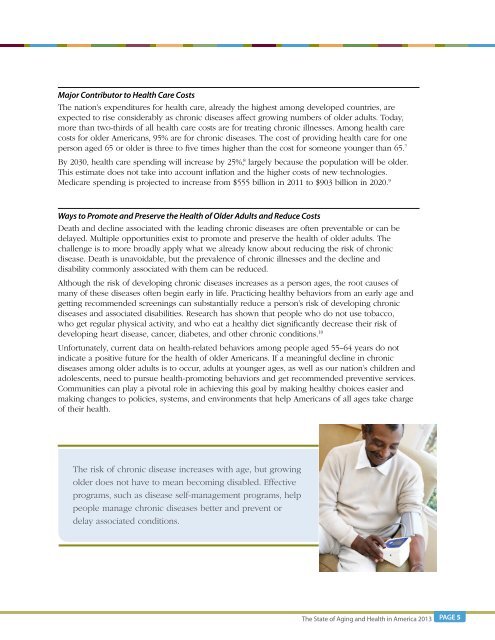Division of Population Health
REGzG
REGzG
- No tags were found...
You also want an ePaper? Increase the reach of your titles
YUMPU automatically turns print PDFs into web optimized ePapers that Google loves.
Major Contributor to <strong>Health</strong> Care Costs<br />
The nation’s expenditures for health care, already the highest among developed countries, are<br />
expected to rise considerably as chronic diseases affect growing numbers <strong>of</strong> older adults. Today,<br />
more than two-thirds <strong>of</strong> all health care costs are for treating chronic illnesses. Among health care<br />
costs for older Americans, 95% are for chronic diseases. The cost <strong>of</strong> providing health care for one<br />
person aged 65 or older is three to five times higher than the cost for someone younger than 65. 7<br />
By 2030, health care spending will increase by 25%, 8 largely because the population will be older.<br />
This estimate does not take into account inflation and the higher costs <strong>of</strong> new technologies.<br />
Medicare spending is projected to increase from $555 billion in 2011 to $903 billion in 2020. 9<br />
Ways to Promote and Preserve the <strong>Health</strong> <strong>of</strong> Older Adults and Reduce Costs<br />
Death and decline associated with the leading chronic diseases are <strong>of</strong>ten preventable or can be<br />
delayed. Multiple opportunities exist to promote and preserve the health <strong>of</strong> older adults. The<br />
challenge is to more broadly apply what we already know about reducing the risk <strong>of</strong> chronic<br />
disease. Death is unavoidable, but the prevalence <strong>of</strong> chronic illnesses and the decline and<br />
disability commonly associated with them can be reduced.<br />
Although the risk <strong>of</strong> developing chronic diseases increases as a person ages, the root causes <strong>of</strong><br />
many <strong>of</strong> these diseases <strong>of</strong>ten begin early in life. Practicing healthy behaviors from an early age and<br />
getting recommended screenings can substantially reduce a person’s risk <strong>of</strong> developing chronic<br />
diseases and associated disabilities. Research has shown that people who do not use tobacco,<br />
who get regular physical activity, and who eat a healthy diet significantly decrease their risk <strong>of</strong><br />
developing heart disease, cancer, diabetes, and other chronic conditions. 10<br />
Unfortunately, current data on health-related behaviors among people aged 55–64 years do not<br />
indicate a positive future for the health <strong>of</strong> older Americans. If a meaningful decline in chronic<br />
diseases among older adults is to occur, adults at younger ages, as well as our nation’s children and<br />
adolescents, need to pursue health-promoting behaviors and get recommended preventive services.<br />
Communities can play a pivotal role in achieving this goal by making healthy choices easier and<br />
making changes to policies, systems, and environments that help Americans <strong>of</strong> all ages take charge<br />
<strong>of</strong> their health.<br />
The risk <strong>of</strong> chronic disease increases with age, but growing<br />
older does not have to mean becoming disabled. Effective<br />
programs, such as disease self-management programs, help<br />
people manage chronic diseases better and prevent or<br />
delay associated conditions.<br />
The State <strong>of</strong> Aging and <strong>Health</strong> in America 2013 PAGE 5


